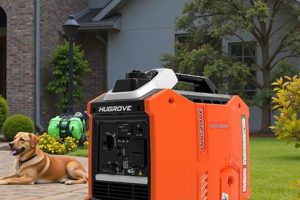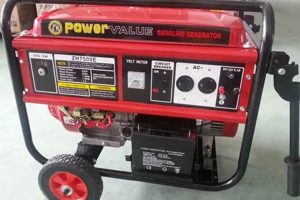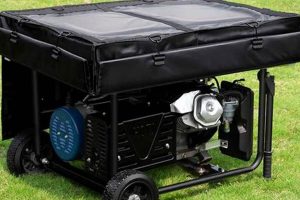Lubrication is essential for the smooth operation and longevity of portable power equipment. The appropriate lubricant reduces friction between moving parts within the engine, minimizing wear and tear. This fluid also plays a crucial role in cooling the engine by dissipating heat generated during operation. Selecting the correct viscosity grade, determined by the manufacturer’s recommendations and the ambient operating temperature, ensures optimal performance and protection.
Proper engine care, including regular maintenance and the use of the specified lubricant, significantly extends the lifespan of portable generators. Preventing premature engine failure safeguards the investment in the equipment and ensures reliable power during outages or remote activities. The development of specialized lubricants for small engines has contributed significantly to their increased efficiency and durability over time.
This discussion will further explore critical aspects of engine lubrication, covering topics such as viscosity grades, oil types (conventional, synthetic, and synthetic blends), and the importance of adhering to a regular maintenance schedule. It will also address common questions regarding oil changes, oil filters, and troubleshooting potential lubrication-related issues.
Essential Lubrication Tips for Portable Generators
Maintaining proper lubrication is crucial for optimal generator performance and longevity. These tips offer guidance on selecting and managing the correct lubricant.
Tip 1: Consult the Owner’s Manual: Always refer to the manufacturer’s recommendations for the specific viscosity grade and type of oil required for the generator model. This information is essential for ensuring proper engine protection.
Tip 2: Consider Operating Temperature: Ambient temperature significantly influences oil viscosity. Select the appropriate viscosity grade based on the expected operating temperature range.
Tip 3: Check Oil Level Regularly: Before each use, check the oil level using the dipstick and add oil as needed to maintain the correct level. Never overfill.
Tip 4: Adhere to Recommended Oil Change Intervals: Follow the manufacturer’s guidelines for oil change frequency. Regular oil changes remove contaminants and maintain oil effectiveness.
Tip 5: Use the Correct Oil Type: Choose conventional, synthetic, or synthetic blend oil as specified in the owner’s manual. Avoid mixing different oil types.
Tip 6: Replace the Oil Filter: Change the oil filter with each oil change to ensure optimal filtration and engine protection.
Tip 7: Dispose of Used Oil Properly: Used oil should be collected and disposed of responsibly at designated recycling centers or collection points.
Tip 8: Inspect for Leaks: Regularly check for oil leaks around the engine and address any leaks promptly to prevent damage and environmental contamination.
Following these lubrication best practices ensures reliable generator operation, extends engine life, and minimizes the risk of costly repairs.
By understanding and implementing these guidelines, generator owners can contribute significantly to the efficient and long-lasting performance of their equipment.
1. Viscosity
Viscosity, a measure of a fluid’s resistance to flow, plays a critical role in the effective lubrication of portable generators. Selecting the correct viscosity grade is essential for maintaining engine health and ensuring optimal performance across varying operating temperatures. A lubricant’s viscosity changes with temperature; it thickens in cold conditions and thins at higher temperatures. Using an oil with inadequate viscosity for a given temperature can lead to insufficient lubrication, increased friction, and accelerated engine wear. For example, employing a low-viscosity oil during hot weather operation may result in a loss of oil pressure and inadequate protection of critical engine components. Conversely, using a high-viscosity oil in cold weather can hinder engine startup and proper oil circulation.
Manufacturers specify recommended viscosity grades for their portable generators, often expressed using the Society of Automotive Engineers (SAE) viscosity grading system (e.g., SAE 30, SAE 10W-30). These recommendations consider the engine design and anticipated operating temperature ranges. Multi-grade oils, designated with a “W” (for winter), provide adequate viscosity across a broader temperature range, enabling reliable operation in both cold and hot conditions. Understanding these viscosity gradings and adhering to manufacturer recommendations is fundamental to maximizing generator lifespan and performance. Selecting the wrong viscosity can lead to increased fuel consumption, reduced power output, and potentially catastrophic engine damage.
Appropriate viscosity selection is not merely a technical detail but a practical necessity for ensuring reliable and efficient operation of portable generators. By understanding the relationship between viscosity, temperature, and engine performance, operators can make informed decisions that protect their investment and guarantee power availability when needed. Neglecting this critical aspect of generator maintenance can have significant long-term consequences, potentially leading to costly repairs or premature engine failure.
2. Type
The type of oil employed in portable generators significantly impacts engine performance, longevity, and overall operational efficiency. Three primary types of oil are commonly available: conventional, synthetic, and synthetic blends. Each possesses distinct characteristics influencing its suitability for specific applications and operating conditions.
Conventional oil, derived from refined crude oil, offers adequate lubrication for standard operating conditions. However, it degrades faster than synthetic alternatives, necessitating more frequent oil changes. Synthetic oil, engineered from chemically modified base oils, provides superior performance in extreme temperatures, offering enhanced resistance to breakdown and improved wear protection. Synthetic blends combine the benefits of both conventional and synthetic oils, offering a balance of cost-effectiveness and enhanced performance characteristics. Selecting the appropriate oil type depends on factors such as operating temperature, engine design, and desired maintenance intervals. For instance, generators operating in consistently high temperatures may benefit from the enhanced thermal stability of synthetic oils, while those used less frequently might suffice with conventional oil.
Understanding the nuances of each oil type enables informed decision-making regarding lubricant selection, optimizing generator performance and lifespan. While conventional oil often represents a more economical initial investment, the long-term benefits of synthetic or synthetic blend oils, including extended drain intervals and improved engine protection, can contribute to overall cost savings and enhanced reliability. Therefore, careful consideration of operating conditions and performance requirements, in conjunction with manufacturer recommendations, is essential for selecting the optimal oil type for a portable generator.
3. Capacity
Understanding the oil capacity of a portable generator is crucial for proper maintenance and operation. Capacity refers to the specific volume of oil required to fill the engine’s crankcase to the correct level. This volume is precisely engineered to ensure adequate lubrication of all moving parts without overfilling, which can lead to detrimental effects. Overfilling can cause increased crankcase pressure, oil leaks, and potential damage to seals and gaskets. Conversely, underfilling deprives the engine of sufficient lubrication, leading to increased friction, accelerated wear, and potential overheating. Knowing the precise oil capacity, readily available in the owner’s manual, and adhering to it during oil changes, prevents these issues and ensures optimal engine performance and longevity. For example, a generator with a capacity of 0.6 quarts requires precisely that amount; adding more, even a seemingly negligible amount, risks engine damage.
Practical application of this understanding involves checking the oil level regularly using the dipstick and adding oil as needed to maintain the correct level within the specified capacity. Oil level should be checked before each use, especially for generators subjected to extended operation. During an oil change, it’s essential to drain the old oil completely and then refill with the precise amount indicated in the manual. Never rely solely on visual estimates when adding oil; always use the dipstick to confirm the correct level is within the specified capacity. This diligent attention to detail safeguards the engine and contributes significantly to its operational lifespan. Furthermore, understanding capacity facilitates the procurement of the correct amount of oil required for an oil change, avoiding unnecessary waste or shortages.
Accurate knowledge and application of a generator’s oil capacity contribute significantly to maintaining engine health, optimizing performance, and extending operational lifespan. Neglecting this seemingly simple aspect of maintenance can have significant long-term repercussions, including costly repairs or premature engine failure. Therefore, understanding capacity is not merely a technical detail but a fundamental aspect of responsible generator ownership and operation.
4. Change Intervals
Adhering to proper oil change intervals is fundamental to maintaining the long-term health and performance of portable generators. These intervals, typically specified in operating hours or calendar time within the owner’s manual, dictate how frequently the engine oil requires replacement. Several factors influence the determination of these intervals, including engine design, operating conditions, and oil type. Ignoring recommended change intervals leads to a gradual degradation of the oil’s lubricating properties. As oil ages, it accumulates contaminants, such as combustion byproducts and microscopic metal particles from engine wear. This degradation reduces the oil’s ability to effectively lubricate and cool the engine, increasing friction, accelerating wear, and potentially leading to overheating and premature engine failure. For instance, continuous operation under heavy load in a dusty environment necessitates more frequent oil changes compared to occasional use under light loads in clean conditions. Similarly, conventional oils typically require more frequent changes than their synthetic counterparts due to differing degradation rates.
The practical significance of adhering to recommended change intervals translates directly into extended engine lifespan and reduced maintenance costs. Regular oil changes remove accumulated contaminants and replenish the oil’s protective properties, minimizing wear and tear on critical engine components. This proactive maintenance approach safeguards the generator investment and ensures reliable power availability when needed. Failure to adhere to these intervals, however, can result in costly repairs, reduced performance, and potentially catastrophic engine damage. Consider a scenario where a generator, subjected to extended use without proper oil changes, experiences accelerated wear on its bearings, ultimately leading to engine seizure and necessitating a complete engine rebuild a significantly more expensive outcome compared to the cost of routine oil changes.
In summary, oil change intervals represent a critical element of preventative maintenance for portable generators. Understanding the factors influencing these intervals, adhering to manufacturer recommendations, and recognizing the potential consequences of neglecting this essential maintenance task contribute significantly to maximizing engine lifespan, optimizing performance, and ensuring long-term reliability. This proactive approach not only protects the investment in the generator but also guarantees consistent power availability when needed, minimizing the risk of disruptions due to preventable maintenance issues.
5. Level Checks
Regular oil level checks constitute a critical aspect of portable generator maintenance, directly impacting engine longevity and performance. Maintaining the correct oil level ensures adequate lubrication of internal components, preventing excessive wear, overheating, and potential engine failure. Neglecting routine level checks exposes the engine to increased risk of damage and significantly shortens its operational lifespan. The following facets detail the importance and practical application of regular oil level checks.
- Frequency
Oil level checks should be performed before each generator use. This practice allows for the identification of potential leaks or excessive oil consumption, enabling timely intervention before significant damage occurs. For generators experiencing infrequent use, monthly checks are recommended to account for potential seepage or evaporation. This proactive approach ensures the engine remains adequately lubricated, even during periods of inactivity.
- Procedure
Accurate level checks require a consistent procedure. The generator should be positioned on a level surface, and the engine allowed to cool completely before checking. Remove the dipstick, wipe it clean, reinsert it fully, and then remove it again to observe the oil level. The oil level should fall within the designated markings on the dipstick, typically indicated by crosshatches or the letters “F” and “L” for full and low, respectively. This straightforward process provides a reliable indication of the oil level and guides necessary top-ups.
- Interpretation
Correctly interpreting the dipstick reading is crucial for maintaining the appropriate oil level. An oil level below the “L” mark indicates the need for additional oil. Overfilling, indicated by a level above the “F” mark, is equally detrimental and requires draining excess oil to prevent engine damage. Understanding these markings and their implications ensures the oil level remains within the safe operating range, promoting engine health and longevity.
- Consequences of Neglect
Neglecting routine oil level checks exposes the generator to significant risks. Low oil levels can lead to insufficient lubrication, increased friction between moving parts, overheating, and ultimately, catastrophic engine failure. Conversely, overfilling can cause excessive crankcase pressure, oil leaks, and damage to seals and gaskets. These consequences underscore the importance of incorporating regular level checks into a preventative maintenance routine, preserving engine integrity and ensuring reliable generator operation.
In conclusion, routine oil level checks are a simple yet crucial preventative maintenance task for portable generators. By understanding the frequency, procedure, and interpretation of level checks, and recognizing the potential consequences of neglect, operators can significantly extend the lifespan of their generators and ensure reliable power availability. This proactive approach protects the investment in the equipment and minimizes the risk of disruptions caused by preventable maintenance issues.
6. Disposal
Proper disposal of used oil from portable generators is critical due to its environmental impact. Used oil contains contaminants harmful to the environment, including heavy metals and carcinogens. Improper disposal, such as pouring it onto the ground, down drains, or into landfills, contaminates soil and water sources, posing a threat to ecosystems and human health. These contaminants can persist in the environment for extended periods, causing long-term damage. For instance, oil dumped into a storm drain can contaminate local waterways, harming aquatic life and potentially entering the human food chain. Even small quantities of used oil can contaminate substantial volumes of water, rendering it unsafe for consumption or recreational use.
Responsible disposal practices mitigate these environmental risks. Designated collection centers and recycling facilities accept used oil, ensuring its proper processing and minimizing environmental impact. Recycling used oil reduces the demand for new oil production, conserving natural resources and minimizing waste. Many automotive repair shops and some retail stores participate in used oil collection programs, offering convenient disposal options for generator owners. Storing used oil securely in sealed containers, clearly labeled, prevents accidental spills and facilitates safe transport to collection points. Failing to adhere to responsible disposal methods can result in penalties and fines, underscoring the legal and ethical obligations associated with proper used oil management.
Responsible disposal practices constitute an essential component of portable generator maintenance. Understanding the environmental impact of improper disposal and the benefits of recycling underscores the significance of adhering to proper procedures. This proactive approach not only protects the environment but also contributes to sustainable resource management and ensures compliance with environmental regulations. By prioritizing responsible disposal, generator owners contribute to a cleaner and healthier environment for present and future generations, mitigating the long-term consequences of improper waste management practices.
Frequently Asked Questions
This section addresses common inquiries regarding lubricant selection and management for portable generators.
Question 1: What happens if incorrect viscosity oil is used?
Using incorrect viscosity oil can lead to inadequate lubrication, increased engine wear, reduced performance, and potential engine damage. Always consult the owner’s manual for the manufacturer’s recommended viscosity grade.
Question 2: How often should oil be changed in a portable generator?
Oil change intervals are specified in the owner’s manual and typically range from 50 to 100 operating hours or annually, whichever comes first. Severe operating conditions may necessitate more frequent changes.
Question 3: Can synthetic oil be used in any portable generator?
While synthetic oil offers performance advantages, always consult the owner’s manual for compatibility. Some older engines may not be designed for synthetic oil.
Question 4: What does the “W” in multi-grade oil (e.g., 10W-30) signify?
The “W” stands for winter and indicates the oil’s viscosity at lower temperatures. Multi-grade oils provide adequate viscosity across a broader temperature range.
Question 5: How is used oil disposed of properly?
Used oil should never be poured down drains or onto the ground. Collect it in sealed containers and take it to designated recycling centers or automotive service facilities that accept used oil.
Question 6: What indicates an oil leak in a portable generator?
Visible oil stains or puddles beneath the generator, a low oil level despite recent additions, or a burning oil smell during operation all indicate potential leaks. Address leaks promptly to prevent further damage.
Understanding these fundamental aspects of lubrication contributes significantly to the long-term health and reliability of portable generators. Proper oil selection, regular maintenance, and responsible disposal practices are crucial for maximizing engine life and ensuring consistent performance.
For further information on specific generator models, always consult the manufacturer’s documentation and recommendations. The next section delves into the specifics of preventative maintenance schedules.
Conclusion
Appropriate lubrication is paramount for the reliable and enduring operation of portable generators. This exploration has underscored the critical interplay between lubricant selection, maintenance practices, and overall engine health. Key considerations include viscosity selection based on operating temperature, adherence to manufacturer-recommended oil types and change intervals, diligent level checks, and responsible used oil disposal. Neglecting these fundamental aspects jeopardizes engine longevity, compromises performance, and increases the risk of costly repairs or premature failure.
Continued advancements in lubricant technology and ongoing emphasis on preventative maintenance practices promise further enhancements in generator lifespan and efficiency. Diligent adherence to best practices, coupled with a thorough understanding of the critical role lubrication plays, ensures consistent power availability and maximizes the return on investment in portable power equipment. Responsible stewardship of these essential resources safeguards both the equipment and the environment.






